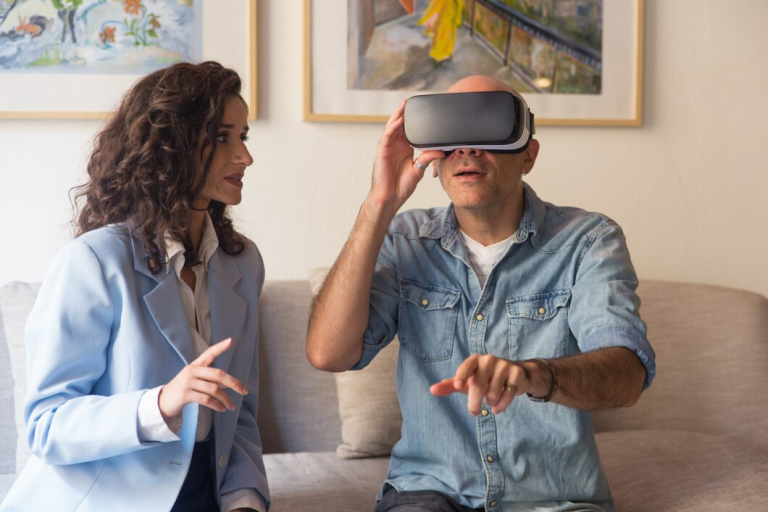How Virtual Reality is Reshaping Architectural Education
Architectural education has traditionally relied on hand-drawn sketches, 3D modeling software, and physical models to teach design principles. However, Virtual Reality (VR) is now revolutionizing how future architects learn, create, and interact with spaces.
By immersing students in full-scale, real-time environments, VR provides a hands-on, experiential learning approach that enhances spatial awareness, technical skills, and design understanding. Schools and firms that integrate VR into their training programs prepare young architects for the future of digital design and construction.
How does VR improve architectural education? Let’s explore the key benefits and applications.
1. Enhancing Spatial Awareness & Design Understanding
Why It’s Important:
One of the biggest challenges for architecture students is understanding scale, depth, and spatial relationships from 2D drawings or 3D models on a screen. VR allows students to step inside their designs and experience them as if they were already built.
How VR Improves Spatial Learning:
- Provides full-scale walkthroughs of designs, improving comprehension of proportion and scale.
- Allows students to test spatial arrangements in real-time, identifying functional and aesthetic issues early.
- Enhances understanding of light, materials, and acoustics in different environments.
Example:
A university architecture program introduced VR-based spatial analysis, leading to a 30% improvement in student design accuracy and fewer scaling errors in final projects.
Best Practice: Use VR simulations in early design courses to help students develop strong spatial reasoning skills before moving to complex projects.
2. Hands-On Virtual Site Visits & Construction Training
Why It’s Important:
Field visits are essential for architectural training, but travel costs, time constraints, and accessibility issues limit students’ exposure to real-world projects. VR solves this by bringing construction sites, historic buildings, and urban environments directly into the classroom.
How VR Improves Site Training:
- Enables virtual site tours of iconic buildings and construction projects worldwide.
- Provides real-time construction simulations, allowing students to see different project phases.
- Allows students to observe building systems, materials, and structural elements without safety risks.
Example:
A leading architecture school partnered with a construction firm to create VR site tours, reducing logistical costs by 40% while exposing students to twice as many projects per semester.
Best Practice: Incorporate VR-based site visits into coursework to give students a broader, more immersive learning experience.
3. Interactive Design Studios for Real-Time Collaboration
Why It’s Important:
Traditional design studios rely on physical models and 2D plans, which can limit creativity and real-time collaboration. With VR, students can work on designs simultaneously in an immersive digital space, improving teamwork and efficiency.
How VR Enhances Architectural Design Studios:
- Supports real-time multi-user collaboration, allowing students and instructors to review designs together in VR.
- Enables instant modifications to form, structure, and materials.
- Reduces reliance on costly physical models, making the design process more sustainable.
Example:
A design studio implemented VR-based collaboration, leading to a 50% faster design iteration process and higher engagement from remote students.
Best Practice: Use cloud-based VR platforms that allow students to work on shared design projects from anywhere.
4. Simulating Real-World Architectural Challenges
Why It’s Important:
Textbooks and lectures can only teach so much—real-world architecture requires problem-solving, adaptability, and site-specific design solutions. VR allows students to simulate and solve real-world challenges before they encounter them in practice.
Key Real-World Applications in VR Training:
- Climate & Environmental Impact Testing – Simulate wind flow, daylighting, and heat gain to optimize sustainability.
- Urban Planning & Infrastructure – Test how buildings interact with pedestrian traffic, public spaces, and city infrastructure.
- Disaster-Resistant Design – Simulate earthquake, flood, and fire scenarios to develop resilient designs.
Example:
A university used VR to train students in designing hurricane-resistant buildings, leading to more innovative, safety-conscious architectural solutions.
Best Practice: Integrate VR-based simulations into capstone projects to help students develop real-world problem-solving skills.
5. Preparing Students for the Future of Digital Architecture
Why It’s Important:
The architectural industry is rapidly adopting Building Information Modeling (BIM), AI-driven design, and VR-based project management. Students trained in VR will be better equipped for careers in digital architecture.
Key Digital Skills VR Helps Develop:
- BIM & VR Integration – Using tools like Autodesk Revit VR, Enscape, and Twinmotion.
- Smart City & AI-Driven Design – Understanding data-driven urban planning.
- Remote Work & Cloud-Based Collaboration – Training in virtual project management and cross-team communication.
Example:
Graduates with VR experience are 40% more likely to be hired by architecture firms specializing in digital design and BIM.
Best Practice: Universities should partner with architecture firms to create VR-focused internship programs, ensuring students gain industry-relevant experience.
Challenges & Solutions in VR Adoption for Architectural Training
| Challenge | Solution |
|---|---|
| High hardware costs | Use affordable headsets like Meta Quest 3 before scaling. |
| Steep learning curve | Offer VR software training as part of the curriculum. |
| Resistance to new technology | Showcase successful VR-based student projects to build confidence. |
| Limited faculty expertise | Partner with VR software companies for instructor training. |
The Future of VR in Architectural Education
As VR technology advances, architecture schools can expect:
- AI-powered VR tutors – Personalized, AI-driven feedback on student designs.
- 5G-enabled real-time VR collaboration – Seamless cloud-based design studios.
- Integration with AR (Augmented Reality) – Blending physical models with digital overlays.
Final Thoughts: Why Architecture Schools Should Invest in VR Training
VR is not just a passing trend—it is becoming a critical tool for training the next generation of architects. The benefits include:
- Enhanced spatial awareness and design understanding
- Access to global architectural sites without travel limitations
- Improved collaboration and teamwork
- Real-world problem-solving experience
- Better career prospects in digital architecture and BIM
Looking to integrate VR into your architecture program? Contact VRchitects today for expert guidance on immersive learning solutions!






